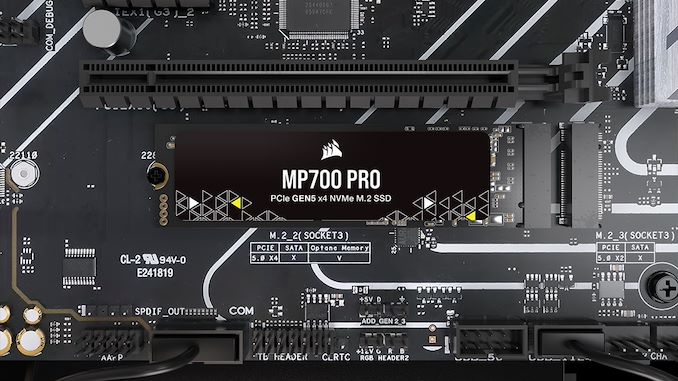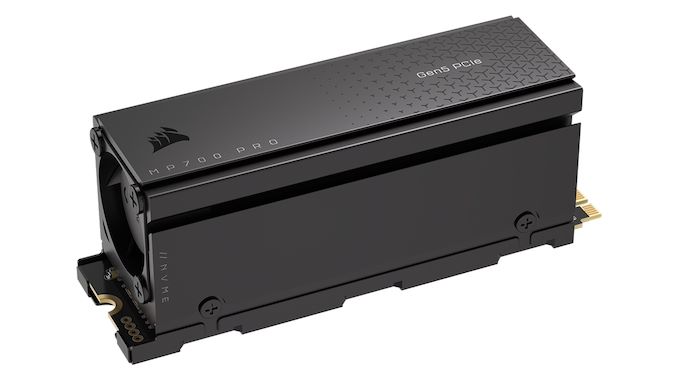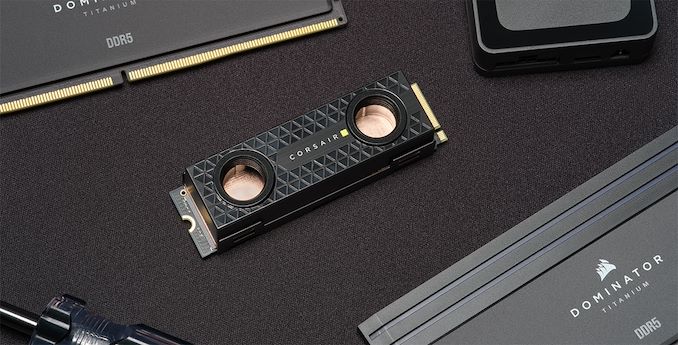Corsair Releases MP700 Pro SSDs: Up 12.4 GB/s With Three Cooling Options
by Anton Shilov on November 15, 2023 10:00 AM EST
Corsair has introduced its MP700 Pro-series solid-state drives with a PCIe 5.0 x4 interface that offer sequential read speed of up to 12.4 GB/s. The new high-end drive family offers a trio of cooling options, including active air cooling and liquid cooling. The SSDs will complement the company's MP700-series PCIe Gen5 drives and will offer a new level of performance for PC enthusiasts.
Corsair's MP700 Pro drives are based on Phison's PS5026-E26 controller as well what initial teardowns have discovered to be 232 layer Micron 3D TLC NAND memory. Compared to their earlier E26-based MP700 drive, Corsair has been able to increase the drive's maximum sequential read speed to 12.4 GB/s and maximum sequential write speed to 11.8 GB/s thanks to the use of faster NAND, which offers a higher 2000 MT/sec transfer rate (versus the original's 1600 MT/sec rate). In addition, the company increased random read speed to 1.5 million IOPS and random write speed to 1.6 million IOPS, which is comparable to speeds offered by enterprise-grade SSDs.
As far as capacity points are concerned, Corsair's MP700 Pro are currently available in 1 TB and 2 TB configurations, whereas 4 TB versions will be available sometimes in the future.
In addition to very high out-of-box performance, there is another selling point that Corsair's MP700 Pro drives have. They are available with three different cooling system to cater different PC form-factors and audiences. For high-performance laptops and compact desktops, Corsair offers MP700 Pro with a simplistic graphene heatspreader; for high-performance desktops, the company will offer these drives with an aluminum heatsink and a fan to ensure sufficient cooling and consistent performance even under high loads; whereas for owners of PCs with custom-built liquid cooling the company will offer a SSDs with a waterblock.
When the first M.2-2280 solid-state drives with a PCIe 5.0 x4 interface hit the market earlier this year, the majority of PCIe Gen5 SSDs topped out at a 10 GB/s sequential reads and writes since fast 3D NAND chips were in short supply. Now that 3D NAND with a 2000 MT/s interface is getting more widespread, Corsair and other manufacturers of SSDs are rolling out drives that can hit 12.4 GB/s read speeds.
In fact, Sabrent and some other makers are working on even faster SSDs with around 14 GB/s read speeds, so it is well possible that we are going to see a yet another 'sub-generation' PCIe Gen5 drives that will saturate a PCIe 4.0 x4 interface.
Source: Corsair













15 Comments
View All Comments
PeachNCream - Thursday, November 16, 2023 - link
I see that 5W number quoted a lot, but what I wonder about is if that number goes up when air expelled by an Airjet passes over a low-profile/slim form factor heatsink which would increase surface area and make use of outlet air for added cooling. I'm pretty sure the Airjet specs only account for the cooling capability of the unit itself. 2280 SSDs are long enough to add hypothetical, supplemental heatsinks.Jansen - Thursday, November 16, 2023 - link
It’ll be interesting to see results with 2400 MT/s chips soon. Even better will be 3200 MT/s using Kioxia/WDC’s BiCS8 process. Might be some low cost but speedy 4-channel designs.Heat seems to be more of an issue with SSD controllers. Perhaps moving to smaller process nodes would help.
meacupla - Thursday, November 16, 2023 - link
From what I've seen, handled, and read, the problem with SSD controller heat has more to do with it sitting low on the SSD. On Gen4/5 NVMe SSDs, the NAND chips get placed at the outer edges, and this causes the controller to have a thicker and less efficient heat pad.IMO, if the manufacturers bothered to slap on a custom vapor chamber, that would improve cooling with generic flat bottom heatsinks.
Threska - Sunday, November 19, 2023 - link
Or motherboards have an integrated heatpipe SSD heatsinkMakaveli - Monday, November 20, 2023 - link
In fact, Sabrent and some other makers are working on even faster SSDs with around 14 GB/s read speeds, so it is well possible that we are going to see a yet another 'sub-generation' PCIe Gen5 drives that will saturate a PCIe 4.0 x4 interface.That should be PCIe 5.0 x 4 interface at the end of this statement?